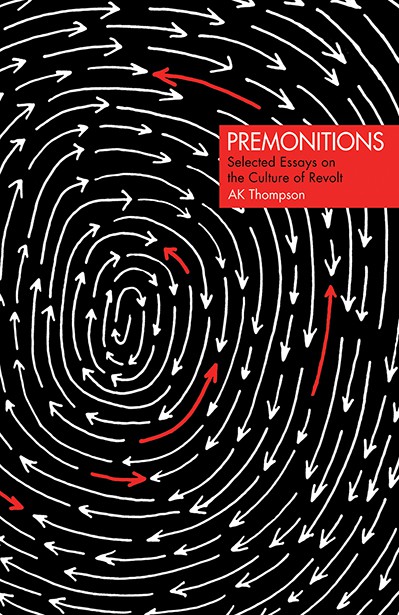Premonitions: Fragments of a Culture of Revolt
AK Thompson’s newest book, Premonitions: Selected Essays on the Culture of Revolt, is focused on strategic and analytical insights about how our social movements work, and don’t, and what they yet may be. AK Press interviews Thompson here on some of the ideas that are central to the book.
AK Press (AKP): Let’s start by having you explain the title of the book, Premonitions. You’ve chosen it in relation to the titles of the two classic collections of Walter Benjamin’s essays, Illuminations and Reflections. How do you see your work in relation to Benjamin’s and what analytical premises are implied by “premonitions”?
AK Thompson (AKT): Walter Benjamin’s contributions have always struck me as being a powerful corrective to those Marxisms that were more narrowly focused on political economy. In Capital, Marx showed us how getting below the level of bourgeois commonsense, which takes the market to be self-evident, made it possible to uncover the “hidden abode” of production where capitalism’s truth was revealed. Benjamin went one further by proposing that this “hidden abode” could be found everywhere. He showed that it was possible to describe capitalism by teasing out the tensions that shot through its culture. In this way, he sought to “grasp an economic process as perceptible.”

Early in his intellectual career, Benjamin observed that the German Romantics had viewed criticism less as an act of disavowal than as one of completion. Although our experience of the world was one of discontinuous fragments, it was possible – through reflection – to reveal these fragments’ “absolute” character. The implication is that the work of analysis can start from anywhere. If you know how to look for it, even the “hidden abode” can be found reflected in the culture. Sometimes, however, we encounter events, experiences, and images that are especially revelatory. The shock of recognition prompts us to reevaluate the world and the struggles that define it. In his essay on surrealism (1929), Benjamin described these experiences as ones of “profane illumination.”
Given the central role that illumination and reflection played in his thought, it was felicitous that these concepts were given as titles to the volumes that made Benjamin a familiar name in the English-speaking world. In assembling my own collection, I felt obliged to signal my debt by following suit. Premonitions are similar to illuminations and reflections in that, as forms of extrapolative reasoning, they reveal how a thing or event can be made to alert us to the broader social process from which it derives. The major difference is that, whereas Benjamin’s concepts placed emphasis on the resolution of accumulated tensions, “premonitions” direct our attention toward the future that will obtain should present dynamics be left undisturbed.
Because of his misgivings with “progress,” which he took to be both a central conceit of capitalist culture and an idea that had blunted class hatred among social democrats, Benjamin urged movements to turn their back on the future and focus more on “the image of enslaved ancestors … than that of happy grandchildren.” Even so, his work discloses a strong premonitory orientation. The concluding line to “Paris, Capital of the Nineteenth Century” (1935), for instance, recounts how “in the convulsions of the commodity economy we begin to recognize the monuments of the bourgeoisie as ruins even before they have crumbled.”
This is seductive, but we must resist the temptation to view ruins – even capitalist ruins – as somehow signaling redemption. Premonitory thinking reveals that capitalist ruins point just as logically to barbarism as they do to emancipation. For this reason, premonitions eject us from the continuum of history and deposit us before the moment of decision demanded by politics.
AKP: A crucial premise of the book – building, again, upon Benjamin – is that one can find, through a deep analysis of any particular element of a culture, a microcosm or reflection of (among other things) its social and economic relations. The general contained within the particular. You see one clear antecedent in Marx’s famous examination of the commodity at the beginning of Capital, and also in Henri Lefebvre’s claim that, through an analysis of a small event, one might grasp “the sum total of capitalist society, the nation and its history.” Could you elaborate on how this idea works throughout your book, and maybe give an example?
AKT: For me, revolutionary politics really begins with the realization that everything is about everything. Because we recognize that incremental tinkering will never change the system, we demand a total revolution in all areas of social life; but what does that mean? How do we get a hold of the whole? As an object of analysis, and much more so as one of intervention, “society” is pretty cumbersome. For this reason, it becomes necessary to grasp it through its fragmentary expression. In the end, Benjamin maintained that this method could reveal “in the lifework, the era; and in the era the entire course of history.”
I first began experimenting with this method in Black Bloc, White Riot, where what had seemed like a series of finite debates regarding tactics ended by disclosing a much broader set of concerns regarding the meaning of politics as such. The same idea is at work in Keywords for Radicals, where the dynamics of late capitalism are discovered through the contests over word usage and meaning that arise within radical scenes. In Premonitions, this method is directed primarily toward the cultural artifacts that emerge from radical movements.
This emphasis arose in part from my desire to understand the bond that sometimes develops between activists and particular movement-based artists. I recall, for instance, being struck by the nearly reverential use of images by Eric Drooker in the propaganda of the global justice era. What could this affinity tell us about the struggle? As an object of analysis, the work of art can be grasped more easily than “the movement.” By considering the bases of its resonance, it becomes possible to detect movement dynamics that might otherwise remain invisible.
Let me give you an example. The following image was used by the Direct Action Network to promote actions against the IMF and World Bank in DC on April 16, 2000.

For those with a background in art history, Drooker’s citation of Goya’s Massacre of the Third of May is fairly clear. Overlapping this citation, however, is a more oblique reference to Joshua’s assault on Jericho. The Goya reference is accusatory but foregrounds defeat; the Joshua reference testifies to the power of faith. By collapsing them into a single image, Drooker suggests how the movement, through faith, might triumph over the massacre that seems immanent to the confrontation they’ve initiated. It’s a seductive proposition, and it’s easy to see why it resonated with a political generation rediscovering the promise and perils of direct action.
It’s important to recall, however, that most activists are not art historians. For this reason, the image’s appeal must arise from something other than the conscious recognition of its animating citations. Why did nineteenth-century Romantic motifs resonate so strongly with a movement that took “Another World Is Possible” to be its profession of faith? In the end, my analysis suggested that the movement was stuck in an unconscious repetition of the dynamics that had plagued its predecessor. It reiterated the ambivalence of Romanticism’s anti-capitalism, which tended to function as a kind of loyal opposition within the horizon of bourgeois thought. Assembling this constellation gave me a better grasp on the movement’s shortcomings, and it helped me to envision concrete strategies for moving forward.
AKP: Such an analysis reminds me of another thing I liked about your book. Because you encourage it in your Introduction, I often found myself reading the word “analysis” in its Freudian sense. Throughout the book you use terms like neurosis, drives, wish images, repression, and trauma. It’s as if you put the whole culture on the analyst’s couch. Can you talk a little about how psychoanalysis fits into your framework?
AKT: Benjamin drew on psychoanalytic insights without feeling terribly beholden to the tradition, which was still very much in formation at the time. He was hostile to Jung for his reliance on archetypes, but his thinking often ran parallel to that of Freud who, especially in later works like The Future of an Illusion and Civilization and its Discontents, had become preoccupied with broader social and historical concerns. As an intellectual tradition, psychoanalysis is torn between radical and conservative poles. Freud’s unsparing critique of bourgeois morals coexists with the reality principle’s implicit demand for accommodation. Similarly, one can detect a tension between the tradition’s analytic dimension (which tends to unsettle normative presumptions regarding social dynamics) and its therapeutic one (which emphasizes work at the level of the individual psyche).
My own use of psychoanalytic concepts is largely in keeping with Benjamin’s, and with that of the Frankfurt School more generally. Benjamin’s main contention was that people collectively (and not solely as individuals) are driven by a search for resolution that leads both to wishful thinking and to historical recollection – though the latter most often gets refracted through myth. As with Freud, who thought that dreams arose from our practical inability to obtain a desired object (or even to acknowledge our desire for it), Benjamin perceived material culture to be a kind of ongoing dream work in which the social desire for absolution found expression in distorted form.
The task therefore becomes one of bringing the desires that animate existing forms into consciousness so that the struggle can begin to find its concrete referent. For Marx (and Benjamin was fond of this quote), “our motto must be: reform of consciousness not through dogma, but by analyzing the mystical consciousness that is unintelligible to itself… It will then become clear that the world has long dreamed of possessing something of which it only has to be conscious in order to possess it in reality… It is not a question of drawing a great mental dividing line between past and future, but of realizing the thoughts [desires] of the past.”
AKP: How about Romanticism, which is a much more explicit thread that runs through the essays? How does it help us understand where we are politically, or equip us for the struggles ahead?
AKT: Ever since their mutual inception at the end of the eighteenth century, social movements and Romanticism have been difficult to disentangle. Both traditions emerged in relation to the bourgeois revolutions of that time, and both flourished within the public sphere. From its hatred of dark satanic mills to its celebration of the heart that watches and receives, Romanticism generated an impressive catalogue of wish images that continue to resonate today. But Romanticism’s anti-capitalism was always ambivalent. Not only did it tend to fall into the role of loyal opposition by siding with the “ought” of bourgeois idealism, which (despite standing in opposition to the “is” of capitalism’s dominant empiricism) could never attain a synthesis of the kind called for by Marx in his Theses on Feuerbach, it also swung pendulously between the utopian and the imperious. Many scholars have identified a Romantic kernel at the heart of fascism.
Given these dynamics, I think the challenge for anarchists and communists today is to acknowledge Romanticism’s enduring resonance as a mode of anti-capitalist critique while recognizing that (in and of itself) this critique is not enough and that (when left unchecked) the desires it unleashes can be dangerous and unpredictable.
AKP: Having published a number of books on fascism in recent years, I couldn’t help but notice how certain Benjamin-inflected phrases call to mind contemporary definitions of fascism. For instance, you say that Benjamin “proposed that resonant images enabled people to anticipate the future by recalling traces of a mythical past whose promise had yet to be fulfilled” or, to consider a simpler take, “the present dreams the future by way of a detour through the mythic past.” This seems almost perfectly to describe what drives fascism, so how do you respond to its recent resurgence?
AKT: Benjamin was keenly aware of both fascism and its allure. In his famous “work of art” essay (1936), he began by dispensing with notions of genius and creativity, which he claimed led to a “processing of data in the Fascist [and, we might add, Romantic] sense.” Instead, he sought to focus on the contradictions inherent in the developmental tendencies of art as expressed under definite conditions. These tendencies were contradictory, and he took those contradictions and their manifest form in the culture to be reflective of contradictions in the base. For this reason, Benjamin urged us to read his theses not merely as descriptions but as weapons in the struggle against fascism. This struggle, he maintained, would proceed through the politicization of aesthetics, which he contrasted to fascism’s aestheticization of politics and the cult of death to which it gave birth.
But while fascism has actively exploited wish images, they are by no means unique in sensing their allure. Indeed, it is precisely because wish images are so pervasive that fascism is capable of gaining ground. Because a mythic resolution is always easier to attain than a profane, material one, fascism can provide pathways to fulfillment that are for the most part unavailable to communists, anarchists, and those we would seek to recruit. Since this is the case, it might seem prudent to disavow wish images and focus instead on concrete conditions and concrete demands. I’m sympathetic to this conclusion; however, I think it’s dangerous to cede the field.
Wish images give form to the longing for resolution, but they do so in a refracted, mythical way. Following Benjamin (and echoing Marx), I believe our aim must therefore be to make the animating desire clear to itself so that it can be decoupled from the inadequacy of its posited resolution. From there, this same desire might find fulfillment through the profane demands of revolutionary politics. Left to their own devices, wish images are just as likely to fall into fascism’s orbit as they are to yield radical anti-capitalist conclusions. In contrast, when we commit to prying the animating desire from its wish-image cathexis, the effect can be like splitting the atom.
Concretely speaking, I think this means that communists and anarchists need to get better at developing modes of critique that don’t estrange us from the desires that animate mainstream culture. I understand the subcultural reflex, but the solace it affords must be measured against the social disconnect that arises when the critique is understood (correctly, I think) as a repudiation – rather than a suggestion regarding the realization – of the wish. Such repudiations leave people more open to fascism, which tends to affirm ordinary desires (e.g. for security) before binding them to dangerous, mythic resolutions.
I also think we need to get better at describing what a resolution to the historical accumulation of unrealized desires might look like in concrete terms. The challenge is that, while fascists can point to mythic futures and mythic pasts, the only things that communists and anarchists can responsibly point to are the tasks that accumulate whenever a decision is made. Still, people are more likely to assume such responsibilities when the desire that drives them has been affirmed and when the posited resolution seems more compelling than the myth to which it had previously adhered. •
First published on the AK Press website.





